
For nearly 40 years, Toyo Ito has pursued excellence. His work has not remained static and has never been predictable. He has been an inspiration and influenced the thinking of younger generations of architects both within his land and abroad. — Glenn Murcutt, Pritzker Juror
Contrary to the popular choice of Steven Holl, in this year's Pritzker Bets thread in the Archinect forum, Toyo Ito takes the prestigious award. Credit goes to members jk3hl, miesian and helenakeys for their insightful predictions (or hopes, to be more accurate).
Steven Ward says, "Yep, there's def a grudge against Holl..."
There's no denying, however, that Toyo Ito is deserving of the Pritzker. Perhaps Holl's year is next.
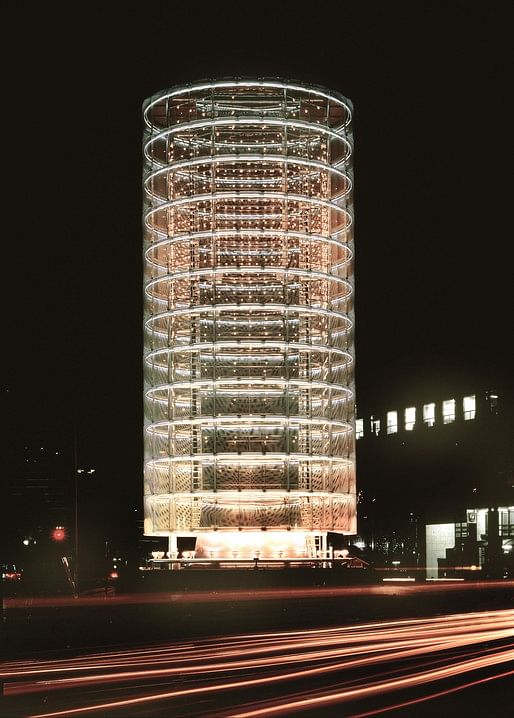
Tower of Winds, 1986, Yokohama-shi, Kanagawa, Japan
Photo by Tomio Ohashi
The 2013 Pritzker Architecture Prize Ceremony Will Be Held in Boston at the John F. Kennedy Library.
Some comments from this year's jurors:
Toyo Ito, his manner, methodology, and generosity of mind and spirit to the younger generation of architects; as well as the brilliance of the constant innovation and execution of his work throughout his long and distinguished career, are qualities that those younger architects would do well to study. Toyo Ito is, quite simply, a master of his profession for all seasons. - Jury Chairman Lord Palumbo
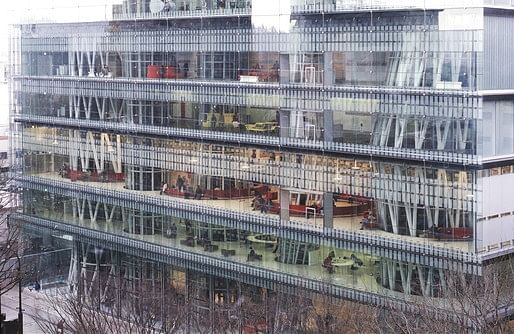
Sendai Mediatheque, 1995—2000, Sendai-shi, Miyagi, Japan
Photo by Tomio Ohashi

Sendai Mediatheque, 1995—2000, Sendai-shi, Miyagi, Japan
Photo by Nacasa & Partners Inc.
His buildings are complex, yet his high degree of synthesis means that his works attain a level of calmness, which ultimately allows the inhabitants to freely develop their life and activities in them. - Alejandro Aravena
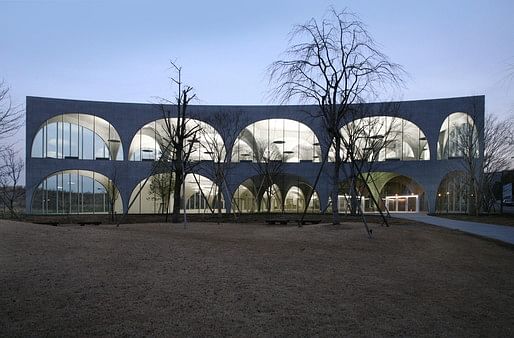
Tama Art University Library (Hachiōji campus), 2004—2007, Hachioji-shi, Tokyo, Japan
Photo by Tomio Ohashi
Toyo Ito’s architecture has improved the quality of both public and private spaces. It has inspired many architects, critics, and members of the general public alike. Along with all others involved with the Pritzker Prize, I am very pleased that he has received the award. - Justice Stephen Breyer
Since building his own house, Toyo Ito has gradually developed and perfected a personal architectural syntax and language, which combine structural, technical ingenuity and formal clarity with convincing rationality and poetic subtlety. - Juhani Pallasmaa
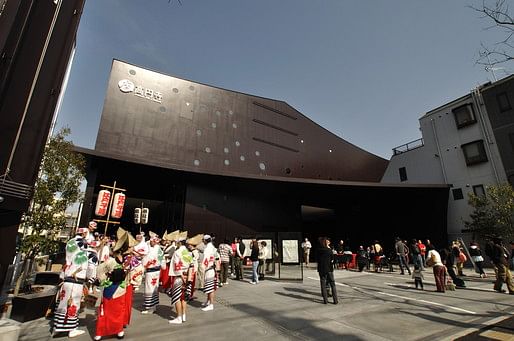
Za-Koenji Public Theatre, 2005—2008, Suginami-ku, Tokyo, Japan
Although Mr. Ito has built a great number of buildings in his career, in my view, he has been working on one project all along, -- to push the boundaries of architecture. And to achieve that goal, he is not afraid of letting go what he has accomplished before. - Yung Ho Chang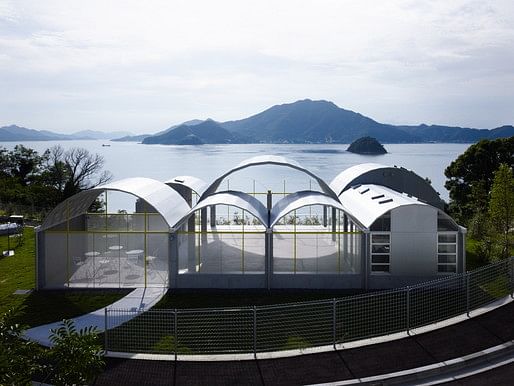
Toyo Ito Museum of Architecture, 2006—2011, Imabari-shi, Ehime, Japan
Photo by Daici Ano
From the Pritzker Foundation...
Toyo Ito, a 71 year old architect whose architectural practice is based in Tokyo, Japan, will be the recipient of the 2013 Pritzker Architecture Prize, it was announced today by Thomas J. Pritzker, chairman of The Hyatt Foundation which sponsors the prize. Ito is the sixth Japanese architect to become a Pritzker Laureate -- the first five being the late Kenzo Tange in 1987, Fumihiko Maki in 1993, Tadao Ando in 1995, and the team of Kazuyo Sejima and Ryue Nishizawa in 2010.

Toyo Ito Museum of Architecture, 2006—2011, Imabari-shi, Ehime, Japan
Photo by Daici Ano
The formal ceremony for what has come to be known throughout the world as architecture’s highest honor will be at the John F. Kennedy Presidential Library and Museum in Boston, Massachusetts on Wednesday, May 29. This marks the first time the ceremony has been held in Boston, and the location has particular significance since it was designed by another Pritzker Laureate, Ieoh Ming Pei who received the prize in 1983.
In making the announcement, Pritzker elaborated, “We are particularly pleased to be holding our ceremony at the Kennedy Library, and it is even more significant because the date is John F. Kennedy’s birthday.”
The purpose of the Pritzker Architecture Prize, which was founded in 1979 by the late Jay A. Pritzker and his wife, Cindy, is to honor annually a living architect whose built work demonstrates a combination of those qualities of talent, vision and commitment, which has produced consistent and significant contributions to humanity and the built environment through the art of architecture. The laureates receive a $100,000 grant and a bronze medallion.
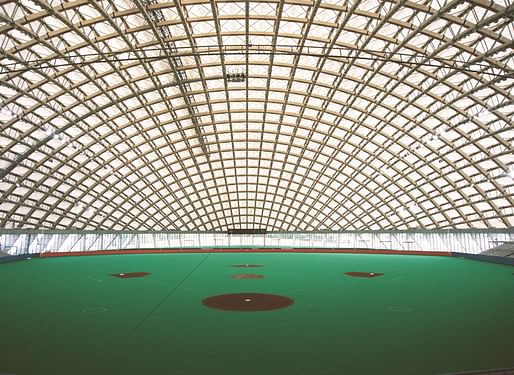
Dome in Odate (multipurpose dome), 1993—1997, Odate-shi, Akita, Japan
Photo by Mikio Kamaya
Pritzker Prize jury chairman, The Lord Palumbo, spoke from his home in the United Kingdom, quoting from the jury citation that focuses on the reasons for this year’s choice: “Throughout his career, Toyo Ito has been able to produce a body of work that combines conceptual innovation with superbly executed buildings. Creating outstanding architecture for more than 40 years, he has successfully undertaken libraries, houses, parks, theaters, shops, office buildings and pavilions, each time seeking to extend the possibilities of architecture. A professional of unique talent, he is dedicated to the process of discovery that comes from seeing the opportunities that lie in each commission and each site. ”
Toyo Ito began working in the firm of Kiyonori Kikutake & Associates after he graduated from Tokyo University’s Department of Architecture in 1965. In1971, he founded his own studio in Tokyo, and named it Urban Robot (Urbot). In 1979, he changed the name to Toyo Ito & Associates, Architects.
He has received numerous international awards, including in 2010, the 22nd Praemium Imperiale in Honor of Prince Takamatsu; and in 2006, The Royal Institute of British Architects’ Royal Gold Medal; and in 2002, the Golden Lion for Lifetime Achievement for the 8th Venice Biennale International Exhibition. Calling him a “creator of timeless buildings,” the Pritzker Jury cites Ito for “infusing his designs with a spiritual dimension and for the poetics that transcend all his works.”
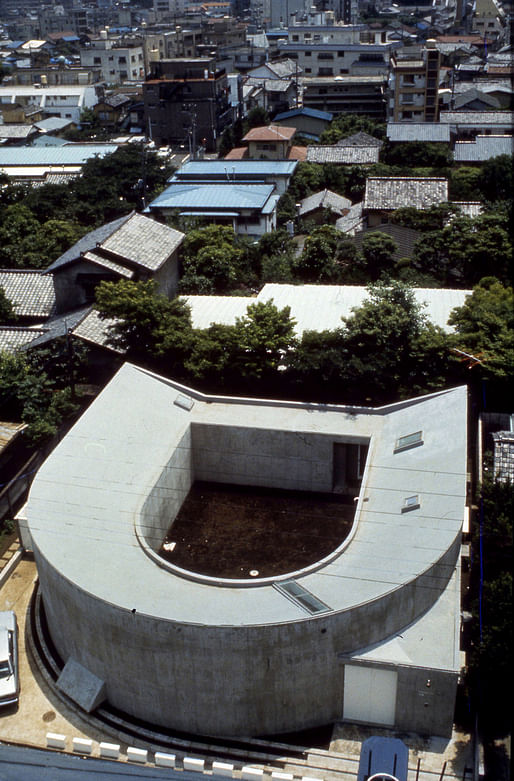
White U (house), 1975—76, Nakano-ku, Tokyo, Japan
Photo by Koji Taki
Toyo Ito made this comment in reaction to winning the prize: “Architecture is bound by various social constraints. I have been designing architecture bearing in mind that it would be possible to realize more comfortable spaces if we are freed from all the restrictions even for a little bit. However, when one building is completed, I become painfully aware of my own inadequacy, and it turns into energy to challenge the next project. Probably this process must keep repeating itself in the future.
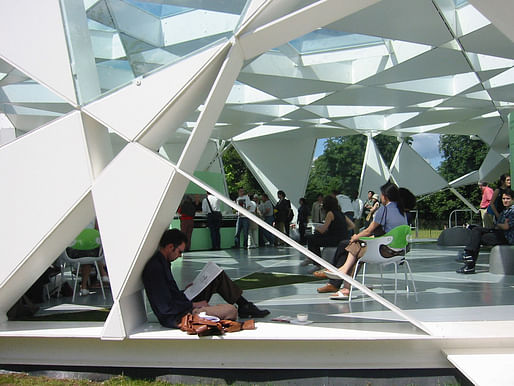
Serpentine Gallery Pavilion, 2002, London, U.K.
“Therefore, I will never fix my architectural style and never be satisfied with my works,” he concluded.
One of his first projects in 1971 was a home in a suburb of Tokyo. Called “Aluminum House,” the structure consisted of wooden frame completely covered in aluminum. Most of his early works were residences. In 1976, he produced a home for his sister, who had recently lost her husband. The house was called “White U” and generated a great deal of interest in Ito’s works. Of most of his work in the 1980’s, Ito explains that he was seeking to erase conventional meaning from his works through minimalist tactics, developing lightness in architecture that resembles air and wind.

Matsumoto Performing Arts Centre, 2000—2004, Matsumoto-shi, Nagano, Japan
Photo by Hiroshi Ueda
He calls the Sendai Mediatheque, completed in 2001 in Sendai City, Miyagi, Japan, one of the high points of his career. In the Phaidon book, Toyo Ito, he explains, “The Mediatheque differs from conventional public buildings in many ways. While the building principally functions as a library and art gallery, the administration has actively worked to relax divisions between diverse programmes, removing fixed barriers between various media to progressively evoke an image of how cultural facilities should be from now on.”
The jury commented on this project in their citation, saying, “Ito has said that he strives for architecture that is fluid and not confined by what he considers to be the limitations of modern architecture. In the Sendai Mediatheque he achieved this by structural tubes, which permitted new interior spatial qualities.”
Another of Ito’s projects commented on by the jury is the TOD’S Omotesando building in Tokyo, “where the building skin also serves as structure,” to quote the jury citation, and further, “Innovative is a word often used to describe Toyo Ito’s works.” Citing the Municipal Funeral Hall in Gifu Prefecture, Tokyo’s Tama Art University Library, and London’s 2002 Serpentine Gallery Pavilion, the jury calls attention to some “of his many inspiring spaces.”
The distinguished jury that selected the 2013 Pritzker Laureate consists of its chairman, The Lord Palumbo, internationally known architectural patron of London, chairman of the trustees, Serpentine Gallery, former chairman of the Arts Council of Great Britain, former chairman of the Tate Gallery Foundation, and former trustee of the Mies van der Rohe Archive at The Museum of Modern Art, New York; and alphabetically: Alejandro Aravena, architect and executive director of Elemental in Santiago, Chile; Stephen Breyer, U.S. Supreme Court Justice, Washington, D.C.; Yung Ho Chang, architect and educator, Beijing, The People’s Republic of China; Glenn Murcutt, architect and 2002 Pritzker Laureate of Sydney, Australia; and Juhani Pallasmaa, architect, professor and author of Helsinki, Finland. Martha Thorne, associate dean for external relations, IE School of Architecture & Design, Madrid, Spain, is the executive director of the prize.
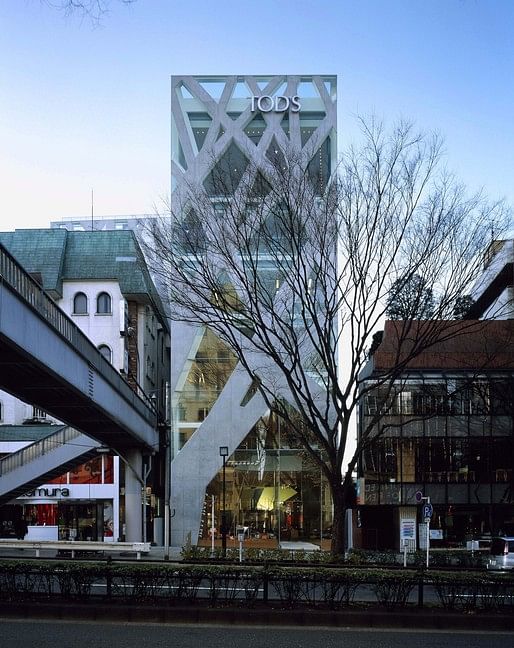
TOD’S Omotesando Building, 2002—2004, Shibuya-ku, Tokyo, Japan
Photo by Nacasa & Partners Inc.
In addition to the previous laureates already mentioned, the late Philip Johnson was the first Pritzker Laureate in 1979. The late Luis Barragán of Mexico was named in 1980. The late James Stirling of the United Kingdom was elected in 1981, Kevin Roche in 1982, Ieoh Ming Pei in 1983, and Richard Meier in 1984. Hans Hollein of Austria was the 1985 Laureate. Gottfried Böhm of Germany received the prize in 1986. Robert Venturi received the honor in 1991, and Alvaro Siza of Portugal in 1992. Christian de Portzamparc of France was elected Pritzker Laureate in 1994. Frank Gehry of the United States was the recipient in 1989, the late Aldo Rossi of Italy in 1990. In 1996, Rafael Moneo of Spain was the Laureate; in 1997 the late Sverre Fehn of Norway; in 1998 Renzo Piano of Italy, in 1999 Sir Norman Foster of the UK, and in 2000, Rem Koolhaas of the Netherlands. Australian Glenn Murcutt received the prize in 2002. The late Jørn Utzon of Denmark was honored in 2003; Zaha Hadid of the UK in 2004; and Thom Mayne of the United States in 2005. Paulo Mendes da Rocha of Brazil was the Laureate in 2006, and Richard Rogers received the prize in 2007. Jean Nouvel of France was the Laureate in 2008. In 2009, Peter Zumthor of Switzerland received the award. In 2010, two Japanese architects were honored, partners Kazuyo Sejima and Ryue Nishizawa of SANAA, Inc. In 2011, Eduardo Souto de Moura of Portugal was the laureate. Last year, Wang Shu of The People’s Republic of China became the laureate.
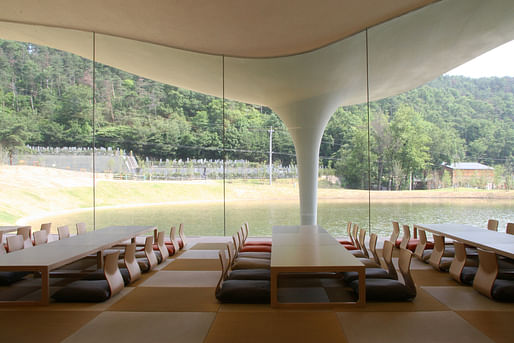

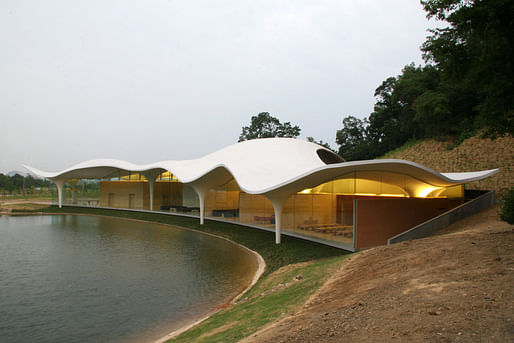
Meiso no Mori Municipal Funeral Hall, 2004—2006, Kakamigahara-shi, Gifu, Japan
The field of architecture was chosen by the Pritzker family because of their keen interest in building due to their involvement with developing the Hyatt Hotels around the world; and because architecture was a creative endeavor not included in the Nobel Prizes. The procedures were modeled after the Nobels, with the final selection being made by the international jury with all deliberations and voting in secret. Nominations are continuous from year to year with hundreds of nominees from countries all around the world being considered each year.
Citation from the Jury
Throughout his career, Toyo Ito has been able to produce a body of work that combines conceptual innovation with superbly executed buildings. Creating outstanding architecture for more than 40 years, he has successfully undertaken libraries, houses, parks, theaters, shops, office buildings and pavilions, each time seeking to extend the possibilities of architecture. A professional of unique talent, he is dedicated to the process of discovery that comes from seeing the opportunities that lie in each commission and each site.
Whoever reviews Ito’s works notices not only a variety of functional programs, but also a spectrum of architectural languages. He has gradually developed and perfected a personal architectural syntax, which combines structural and technical ingenuity with formal clarity. His forms do not comply with either a minimalist or a parametric approach. Different circumstances lead to different answers. From the outset, he developed works that were modern, using standard industrial materials and components for his lightweight structures, such as tubes, expanded meshes, perforated aluminum sheeting and permeable fabrics. His later expressive works have been formed using mostly reinforced concrete. In a truly extraordinary way, he is able to keep structure, space, setting, technology, and place on equal footing. Although the resulting buildings seem effortlessly in balance, they are the result of his deep knowledge of his craft and his ability to deal with all the aspects of architecture simultaneously. In spite of the complexity of his works, their high degree of synthesis means that his works attain a level of calmness that ultimately allows the inhabitants to freely develop their activities within them.
Innovative is a word often used to describe Toyo Ito’s works. This is apparent in the temporary pavilion created in Bruges in 2002 and the TOD’S building in Tokyo in 2004 where the building skin also serves as structure. Innovation can also be demonstrated through his use of traditional materials in non-conventional ways, such as using concrete to create flowing organic forms as he did in the commercial development of VivoCity in Singapore. In addition, his buildings abound with new technological inventions, as can be seen in the Dome in Odate or the Tower of Winds of Yokohama. This innovation is only possible through Ito’s process of carefully and objectively analyzing each situation before proposing a solution.
Ito has said that he strives for architecture that is fluid and not confined by what he considers to be the limitations of modern architecture. In the Sendai Mediatheque, 2000, he achieved this by structural tubes, which permitted new interior spatial qualities. In the Taichung Metropolitan Opera House, the horizontal and vertical network of spaces creates opportunities for communication and connection. Seeking freedom from the rigidity of a grid, Ito is interested in relationships -- between rooms, exterior and interior, and building and surroundings. Toyo Ito‘s work has drawn on inspiration from the principles of nature, as evidenced by the unity achieved between organic-like structures, surface and skin.
Toyo Ito’s personal creative agenda is always coupled with public responsibility. It is far more complex and riskier to innovate while working on buildings where the public is concerned, but this has not deterred him. He has said that architecture must not only respond to one’s physical needs, but also to one’s senses. Of his many inspiring spaces, the Municipal Funeral Hall in Gifu Prefecture of 2006 or the Tama Art University Library in Tokyo, 2007 or the Serpentine Gallery Pavilion in London in 2002 are but three examples that illustrate Ito’s cognizant understanding of the people and the activities within his buildings. His work in favor of “Home-for-All” or small communal spaces for those affected by the earthquake in Japan in 2011 is a direct expression of his sense of social responsibility.
The education of future architects has always been a concern of Toyo Ito. This is apparent in his teaching positions and in the recent rebuilding of the Silver Hut as part of the Toyo Ito Museum of Architecture in Omishima, which is used for workshops and research. Perhaps a more perfect example is his office, which is like a school where young architects come to work and learn. It is evident that while innovating and pushing the boundaries of architecture forward, he does not close the road behind him. He is a pioneer and encourages others to benefit from his discoveries and for them to advance in their own directions as well. In that sense, he is a true master who produces oxygen rather than just consumes it.
Toyo Ito is a creator of timeless buildings, who at the same time boldly charts new paths. His architecture projects an air of optimism, lightness and joy, and is infused with both a sense of uniqueness and universality. For these reasons and for his synthesis of structure, space and form that creates inviting places, for his sensitivity to landscape, for infusing his designs with a spiritual dimension and for the poetics that transcend all his works, Toyo Ito is awarded the 2013 Pritzker Architecture Prize.
About Toyo Ito
Toyo Ito was born on June 1, 1941 in Keijo (Seoul), Korea (Japanese). His father was a business man with a special interest in the early ceramic ware of the Yi Dynasty of Korea and Japanese style paintings. He also was a sports fan of baseball and golf. In 1943, Ito, his mother, and his two elder sisters moved back to Japan. Two years later, his father returned to Japan as well, and they all lived in his father’s hometown of Shimosuwa-machi in Nagano Prefecture. His father died in 1953, when he was 12. After that the rest of family operated a miso (bean paste) making industry. At present, all but one sister who is three years older than Ito, has died.
Ito established his own architecture office in 1971, and the following year he married. His wife died in 2010. They had one daughter who is now 40 and is editing Vogue Nippon.
In his youth, Ito admits to not having a great interest in architecture. There were several early influences however. His grandfather was a lumber dealer, and his father liked to draw plans for his friends’ houses. When Ito was a freshman in high school, his mother asked the early Modernist architect, Yoshinobu Ashihara, who had just returned to Japan from the U.S. where he worked at Marcel Breuer’s office, to design their home in Tokyo.
He was in the third grade of junior high school when he moved to Tokyo and went to Hibiya High School. At the time, he never dreamed he would become an architect—his passion was baseball. It was while attending the University of Tokyo that architecture became his main interest. For his undergraduate diploma design, he submitted a proposal for the reconstruction of Ueno Park, which won the top prize of the University of Tokyo.
Toyo Ito began working in the firm of Kiyonori Kikutake & Associates after he graduated from Tokyo University’s Department of Architecture in 1965. By 1971, he was ready to start his own studio in Tokyo, and named it Urban Robot (Urbot). In 1979, he changed the name to Toyo Ito & Associates, Architects.
He has received numerous international awards, including in 2010, the 22nd Praemium Imperiale in Honor of Prince Takamatsu; in 2006, The Royal Institute of British Architects’ Royal Gold Medal; and in 2002, the Golden Lion for Lifetime Achievement for the 8th Venice Biennale International Exhibition. All of his honors are listed in the fact summary of this media kit. He has been a guest professor at the University of Tokyo, Columbia University, the University of California, Los Angeles, Kyoto University, Tama Art University, and in the spring semester of 2012, he hosted an overseas studio for Harvard’s Graduate School of Design, the first in Asia.
His works have been the subject of museum exhibitions in England, Denmark, the United States, France, Italy, Chile, Taiwan, Belgium, Spain and numerous cities in Japan. Publications by and about him have appeared in all of those countries and more. He holds Honorary Fellowships in the American Institute of Architects, Royal Institute of British Architects, the Architecture Institute of Japan, the Tokyo Society of Architects and Building Engineers, and the American Academy of Arts and Sciences.
One of his first projects in 1971 was a home in a suburb of Tokyo. Called “Aluminum House,” the structure consisted of wooden frame completely covered in aluminum. Most of his early works were residences. In 1976, he produced a home for his sister, who had recently lost her husband. The house was called “White U” and generated a great deal of interest in Ito’s works. It was demolished in 1997. Of most of his work in the 1980’s, Ito explains that he was seeking to erase conventional meaning from his works through minimalist tactics, developing lightness in architecture that resembles air and wind.
He calls the Sendai Mediatheque, completed in 2001 in Sendai City, Miyagi, Japan, one of the high points of his career. In the Phaidon book, Toyo Ito, he explains, “The Mediatheque differs from conventional public buildings in many ways. While the building principally functions as a library and art gallery, the administration has actively worked to relax divisions between diverse programs, removing fixed barriers between various media to progressively evoke an image of how cultural facilities should be from now on. This openness is the direct result of its simple structure, consisting of flat concrete slabs (which are honey-comb steel plates with concrete) penetrated by 13 tubes. Walls on each floor are kept to an absolute minimum, allowing the various functions to be freely distributed throughout the open areas between the tubes.”
In delivering the Kenneth Kassler lecture at Princeton University in 2009, Ito explained his general thoughts on architecture:
“The natural world is extremely complicated and variable, and its systems are fluid – it is built on a fluid world. In contrast to this, architecture has always tried to establish a more stable system. To be very simplistic, one could say that the system of the grid was established in the twentieth century. This system became popular throughout the world, as it allowed a huge amount of architecture to be built in a short period of time.
However, it also made the world’s cities homogenous. One might even say that it made the people living and working there homogenous too.
In response to that, over the last ten years, by modifying the grid slightly I have been attempting to find a way of creating relationships that bring buildings closer to their surroundings and environment.” Ito amends that last thought to “their natural environment.”
In the fashionable Omotesando area of Tokyo, Ito designed a building in 2004 for TOD’S, an Italian shoe and handbag company, in which trees are the dominant relationship. The Ito office provides its own description of the project:
“Trees are natural objects that stand by themselves, and their shape has an inherent structural rationality. The pattern of overlapping tree silhouettes also generates a rational flow of forces. Having adapted the branched tree diagram, the higher up the building, the thinner and more numerous the branches become, with a higher ration of openings. Similarly, the building unfolds as interior spaces with slightly different atmospheres relating to the various intended uses.
Rejecting the obvious distinctions between walls and opening, lines and planes, two- and three-dimensions, transparency and opaqueness, this building is characterized by a distinctive type of abstractness. The tree silhouette creates a new image with a constant tension generated between the building’s symbolic concreteness and its abstractness. For this project, we (Ito and his staff) intended to create a building that through its architectural newness expresses both the vivid presence of a fashion brand and strength in the cityscape that will withstand the passage of time.”
After designing critically-acclaimed buildings like Sendai Mediatheque, Ito became an architect of international importance during the early-2000s leading to projects throughout Asia, Europe, North America and South America. Ito designed the Main Stadium for the 2009 World Games in Kaohsiung and the under-construction Taichung Metropolitan Opera House, both in Taiwan. In Europe, Ito and his firm renovated the façade of the Suites Avenue Apartments with striking stainless steel waves and, in 2002, designed the celebrated temporary Serpentine Pavilion Gallery in London’s Hyde Park. Other projects during this time include the White O residence in Marbella, Chile and the never-built University of California, Berkeley Art Museum/Pacific Film Archive in California.
Perhaps most important to Ito, however, are the projects in his home country, made more pressing by the earthquake and tsunami of March 11, 2011. The disaster spurred Ito and a group of other Japanese architects to develop the concept of “Home-for-All” communal space for survivors. As Ito says in Toyo Ito - Forces of Nature published by Princeton Architectural Press:
“The relief centers offer no privacy and scarcely enough room to stretch out and sleep, while the hastily tacked up temporary housing units are little more than rows of empty shells: grim living conditions either way. Yet even under such conditions, people try to smile and make do.... They gather to share and communicate in extreme circumstances – a moving vision of community at its most basic. Likewise, what we see here are very origins of architecture, the minimal shaping of communal spaces.
An architect is someone who can make such spaces for meager meals show a little more humanity, make them a little more beautiful, a little more comfortable.”
For Ito, the fundamental tenets of modern architecture were called into question by “Home-for-All.” He adds, “In the modern period, architecture has been rated highest for its originality. As a result, the most primal themes—why a building is made and for whom—have been forgotten. A disaster zone, where everything is lost offers the opportunity for us to take a fresh look, from the ground up, at what architecture really is. ‘Home-for-All’ may consist of small buildings, but it calls to the fore the vital question of what form architecture should take in the modern era—even calling into question the most primal themes, the very meaning of architecture.”
The Pritzker Jury commented on Ito’s direct expression of his sense of social responsibility citing his work on “Home-for-All.”
Recently, Ito has also thought of his legacy, as apparent by the museum of architecture that bears his name on the small island of Omishima in the Seto Inland Sea. Also designed by Ito, the museum opened in 2011 and showcases his past projects as well as serving as a workshop for young architects. Two buildings comprise the complex, the main building “Steel Hut” and the nearby “Silver Hut,” which is a recreation of the architect’s former home in Tokyo, built in 1984.
18 Comments
Toyo doesn't look 71 years old at all.. I'd have guessed he's in his early 50's xD The asians have surely been hoarding the Pritzker Prize the past few years
That's because it is actually possible to build progressive architecture in Asia right now without running through a minefield and already being famous at the same time. There are many young and middle age talents in the EU that are already doing great work though. Anyways, this has needed to happen for many years. Ito's firm was the inspiration and training for many of the current great architects in japan, and still produces unique buildings today...
Toyo doesn't look 71 years old at all..
Thats because they eat right in Japan.
Karl Fischer snubbed yet again.
Congrats to Mr. Ito! Well- deserved.
Likewise congrats to Mr. Ito. I think his work is pretty cool, especially next to the depressing work of Mr. Holl, but this is an interesting way of looking at how the Pritzker award is won, something I've always wondered about. In this light, I'll take some (out of context) statements to learn how one wins this coveted award, the equivalent to the Nobel prize for architects.
"The purpose of the Pritzker Architecture Prize... is to honor annually a living architect whose built work demonstrates a combination of those qualities of talent, vision and commitment, which has produced consistent and significant contributions to humanity and the built environment through the art of architecture." - so it must contribute to humanity through it's artistic merit, art being "the quality... according to aesthetic principles, of what is beautiful, appealing, or of more than ordinary significance." What does Mr. Ito say...
“Architecture is bound by various social constraints. I have been designing architecture bearing in mind that it would be possible to realize more comfortable spaces if we are freed from all the restrictions even for a little bit." - So rather than architecture being expressive of humanity, it is bound by the limits it sets itself. Not very optimistic.
"However, when one building is completed, I become painfully aware of my own inadequacy, and it turns into energy to challenge the next project. Probably this process must keep repeating itself in the future. Therefore, I will never fix my architectural style and never be satisfied with my works,” So while the jury commends says "Toyo Ito is a creator of timeless buildings, who at the same time boldly charts new paths.", these paths will never again be trodden becasue this process of exploration can never be repeated.
Jurys comments:
"the constant innovation and execution of his work throughout his long and distinguished career, are qualities that those younger architects would do well to study" Love the innovation, very interesting, but I'm not sure I would call them beautiful, although the illuminated swiss cheese wall looks cool.
"His buildings are complex, yet his high degree of synthesis means that his works attain a level of calmness, which ultimately allows the inhabitants to freely develop their life and activities in them." Sounds great, but 'allowing' inhabitants to freely develope their life might seem like a great achievment for a starchitect, but it's pretty common.
"Toyo Ito has gradually developed and perfected a personal architectural syntax and language, which combine structural, technical ingenuity and formal clarity with convincing rationality and poetic subtlety." I'm convinced, is everybody else? Funny how they still can't seem to use the word 'style' even though he dosen't seem to mind it.
"Although Mr. Ito has built a great number of buildings in his career, in my view, he has been working on one project all along, -- to push the boundaries of architecture. And to achieve that goal, he is not afraid of letting go what he has accomplished before." What about all those great paths he was charting!!! Well, if pushing the boundaries is synonymous with producing "consistent and significant contributions to humanity and the built environment through the art of architecture", so be it.
words, they just don't build them like they used to!
since i got called out - and despite my disappointment that holl hasn't yet received the pritzker - i DO love ito's work and think that this was a great choice.
About time Ito got his Pritzker.
Ito is the man! I really love his white o-house.
On this link you can find an excellent analysis on Ito's work by one if his former management staff running now a promising architectural firm called ABIBOO Architecture: http://www.abiboo.com/arch/analisis-abiboo-toyo-ito-parte-i-de-iii/
I'm so glad he won.
Buildings, they word and build them better than they used to.
This is so wonderful, and so appropriate. Who was the Chinese guy that won the last time? A lot of people (me included) did not believe it or think it was appropriate...
Thayer, I enjoyed reading your critical review of the article but I wouldn't walk away having judged Ito unfairly based on that quote about architecture and social constraints. Humanity, particularly in the recent century, HAS largely been preoccupied with pushing boundaries and constraints so in my opinion its quite accurate to say that his innovative work is culturally expressive. It does seem rather negative at first to primarily see the world as a place full of constraints and boundaries, etc, but i think a heightened awareness of these things is indicative of Ito's genius and sensitivity. I suspect its often the confrontation of boundaries and tension that results in really great works.
sameolddoctor: are you one of them who enjoys clicking the latest tools in rhino, eats grasshopper for breakfast, prefers your buildings all shiny and plasticy, couldn't talk about culture and history from an architectural standpoint, and can barely put together sentences for an intriguing presentation?
jk3hl, I'm glad you enjoyed my critique. You bring up an interesting point about the struggle one has to create a good design despite all the limitations. I would agree that "the confrontation of boundaries and tension...results in really great works", but I would differ on where those boundaries might be. I think constraints of technology, site, and budget have been the catalyst for great architecture, but I'm not sure social constraints have ever been a factor.
I guess it depends on one's perspective. I've heard many architects decry the stupid client or some societal constraint, but I've never felt sorry for them becasue from my view, the archietct's job is to give life to the client's desires. That might mean making them see something they weren't aware of or it might be fine tuning their strong vision, but either way I think one's job is to satisfy society's wishes. It goes back to imagining yourself in someone else's shoes and how you would like to be treated in that position.
This might not sit well with others who see architecture as more of a fine art, ie. a more individually based art, but from my perspective great architects have always been able to do both, express a client's wishes within their cultural, economic, physical context, and express one's own artistic vision, whatever that may be based on. In Mr. Ito's case, he seems to have done that with versatility, I just like to match up marketing with results sometimes to see what there's to learn.
People don't know what they want. Your best bet is to learn something with your client and not deceive them into thinking it is still 200BC.
Use italics when quoting bro, embrace the machine to achieve visual clarity.
"Toyo doesn't look 71 years old at all.. I'd have guessed he's in his early 50's xD The asians have surely been hoarding the Pritzker Prize the past few years"
accesskb, I keep learning from people like you. With such lofty critique to go around, why does one need real critique? I suggest you read what you write.
Not if Denise Scott Brown has anything to say about it!
Block this user
Are you sure you want to block this user and hide all related comments throughout the site?
Archinect
This is your first comment on Archinect. Your comment will be visible once approved.